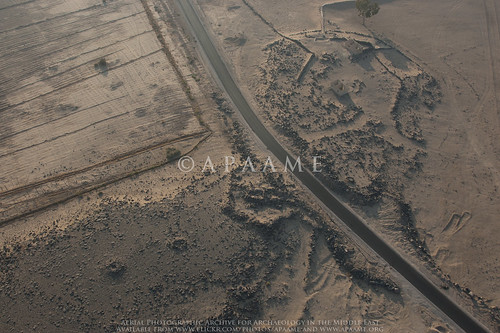Dr. Konstantinos Dino Politis has made available to APAAME his collection of slides and negatives taken in the course of aerial reconnaissance in Jordan over a period from the early 1990s until the early 2000s. The collection includes informal photography taken from commercial flights flying in and out of Amman as well as professional aerial photography taken by Dr. Politis and his team from a helicopter in the course of their research. A starring feature of this collection is the site of Deir Ain Abata, a site found and excavated by Dr. Politis.
Deir Ain Abata was discovered during an archaeological survey in 1986 near the modern town of Safi in Jordan, located just east of the southern Dead Sea basin. Under threat from erosion from its location on a steep slope and its vicinity to the expanding town of Safi, it was decided the site would be excavated and conserved. The site consists of a large reservoir, a triple apsed basilica church with mosaics, a cave on the north aisle of the basilica, a refectory, and a 'Pilgrim's Hostel' north of the refectory. 1991 excavations exposed the church, the western front of which was at peril of continuing to collapse down the face of the mountain. Conservation work was undertaken in 1994 to stabilise the structure. An inscription revealed that the basilica had been renovated in 691AD - during the Umayyad period. The cave was presumed by the Byzantine Christians to be associated with the Old Testament story of Lot, though why this cave was chosen over the many others in its vicinity is unknown to us. Evidence in the cave showed that it had been in use since the Middle Bronze Age II.
You can read more about the site in Dr. Politis' article
The Monastery of Aghios Lot at Deir 'Ain 'Abata in Jordan here:
http://www.hsnes.org/pdf/Lot%20monastery%20article.pdf
Other Dead Sea and Jordan Valley sites feature prominently in the collection- such as Bab edh-Drah,
Khirbet Qazone, Tall Numeira, Bethany on-Jordan, Wadi Kharrar and Tell es-Sa'idiyeh. The collection compliments that of AAJ's aerial reconnaissance in that it contains photographs from before AAJ began its annual program in 1997, as well as photographing sites unknown to or visited at other times by AAJ.
The scanning was undertaken on an EPSON Perfection V700 Photo flatbed scanner at 3000 dpi. Due to the age and condition of the slides, results varied - especially in colour output, but unfortunately also in the sharpness of the image. Where possible colour was corrected, and site coordinates and identification, date and photographer identified and placed in the image metadata, but this was not always possible. We have retained any written information from the slides in the image description.
You can find the collection of photographs here:
The Konstantinos D Politis Collection
If you have any additional information regarding one of the photographs please do not hesitate to leave a comment on the Flickr photo page. Image requests can be made by contacting Dr. Politis. Copyright is retained by the image photographers.







